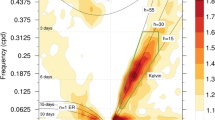Summary
A two-dimensional nonhydrostatic numerical model was used to investigate the behaviour of a cold air gravity current, moving along complex terrain. It is found, that the model with a high horizontal and vertical resolution and with a closure scheme, using the turbulent kinetic energy, is suitable to simulate currents, which have the main features of those found in laboratory experiments.
Simulations are presented for different orographic structures (mountain and valley), for varying thermal stratification of the environmental atmosphere (neutral, stable and stable with an elevated inversion) and for different heights of the cold air reservoir.
The major effect of a hill on the advance of a gravity current is a reduction of the front speed upstream as well as (even stronger) downstream of the obstacle, where the amount of this decrease depends on thermal stratification. Near surface blocking of the air flow on the windward side occurs for all simulations. However, for small depths of the oncoming cold air, the current cannot surmount the hill and remains on the lee side.
Similar content being viewed by others
References
Arritt, R. W., 1985: Numerical studies of thermally and mechanically forced circulations over complex terrain. Colorado State University, Fort Collins, 201 pp.
Baines, P. G., 1977: Upstream influence and Long's model in stratified flows.J. Fluid Mech.,82, 147–149.
Bannon, P. R., 1984: A semi-geostrophic model of frontogenesis over topography.Beitr. Phys. Atmos.,57, 393–408.
Bischoff-Gauss, I., Gross, G., 1989: Numerical studies on cold fronts. Part I: Gravity flows in a neutral and stratified atmosphere.Meteorol. Atmos. Phys.,40, 150–158.
Brümmer, B., 1988: Structure and circulation in the boundary layer at a strong cold front.Beitr. Phys. Atmos.,61, (in press).
Charba, J., 1974: Application of a gravity current model to analysis of squall-line gust fronts.Mon. Wea. Rev.,102, 140–156.
Clough, S. A., 1987: The mesoscale frontal dynamics project.Meteorol. Mag.,116, 32–42.
Coulman C. E., Colquhoun, J. R., Smith, R. K., McInnes, K., 1985: Orographically forced cold fronts—mean structure and motionBound-Layer Meteor.,32, 57–83.
Davies, H. C., 1984: On the orographic retardation of a cold front.Beitr. Phys. Atmosph.,57, 409–418.
Gross, G., 1987: Some effects of deforestation on local climate and nocturnal draingage flow—A numerical study.Bound.-Layer Meteor.,38, 315–337.
Haderlein, K., 1986: Numerische Modellrechnungen zum Verlagerungsverhalten orographisch modifizierter Kaltfronten. Diploma Thesis, Dept. of Meteorology Univ. München, 65 pp.
Hoinka, K. P., 1985: On fronts in central Europe.Beitr. Phys. Atmos.,58, 560–571.
Hoinka, K. P., Volkert, H.: 1987: The german front experiment 1987.Bull. Amer. Meteor. Soc.,68, 1424–1427.
Houghton, D. D., Kasahara, A., 1968: Nonlinear shallow fluid flow over an isolated ridge.Comp. Pure Appl. Math.,21, 1–23.
Lilly, D. K., Klemp J. B., 1979: The effects of terrain shape on nonlinear hydrostatic mountain waves.J. Fluid. Mech.,95, 241–261.
Karman, T., 1940: The engineer grapples with nonlinear problems.Bull. Amer. Math. Soc.,56, 615–683.
Mahrer, Y., Pielke, R. A., 1977: The effects of topography on sea and land breezes in a two-dimensional numerical model.Mon. Wea. Rev. 105, 1151–1162.
Neumann, J., Savijärvi, H.: 1986: The sea breeze on a steep coastBeitr. Phys. Atmos.,59, 375–389.
Ookouchi, Y., Uryu, M., Sawada, R., 1978: A numerical study on the effects of a mountain on the land and sea breezes.J. Meteor. Soc. Japan,56, 368–385.
Pierrehumpert, R. T., Wyman, B., 1985: Upstream effects of mesoscale mountains.J. Atmos. Sci.,42, 977–1003.
Schumann, U., Hauf, T., Höller, H., Schmidt, H., Volkert, H., 1987: A mesoscale model for the simulation of turbulence, clouds and flow over mountains: Formulation and validation examples.Beitr. Phys. Atmos.,60, 413–446.
Schumann, U., 1988: Influence of mesoscale orography on idealized cold fronts.J. Atmos. Sci.,44, 3423–3441.
Shapiro, M. A., 1984: Meteorological tower measurements of a surface cold front.Mon Wea. Rev.,112, 1634–1639.
Young, G. S., Johnson, R. H., 1984: Meso- and Microscale features of a Colorado cold front. J. Climate Appl. Meteor.,23, 1315–1325.
Author information
Authors and Affiliations
Additional information
With 11 Figures
Rights and permissions
About this article
Cite this article
Bischoff-Gauss, I., Gross, G. & Wippermann, F. Numerical studies on cold fronts Part II: Orographic effects on gravity flows. Meteorl. Atmos. Phys. 40, 159–169 (1989). https://doi.org/10.1007/BF01032456
Received:
Revised:
Issue Date:
DOI: https://doi.org/10.1007/BF01032456




